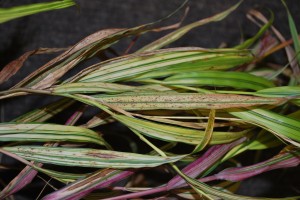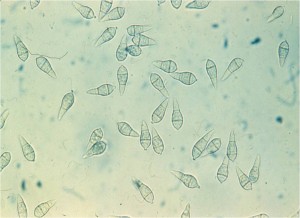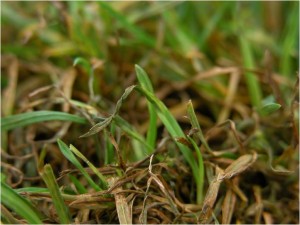Everybody keeps asking me “any gray leaf spot yet?” And I answer, “why yes, but not where you think.” Gray leaf spot was diagnosed last week on samples of Hakonechloa that were submitted from a central New Jersey nursery grower.
Japanese hakone grass has been making inroads into New Jersey landscapes over the last several years. Growing next to hosta in part-shade, hakone grass makes a fine addition to the landscape. Not without problems, however, as hakone often burns up in the direct sun, might not make it through a cold winter, and even worse, is susceptible to gray leaf spot! Of course, the folks inquiring about gray leaf spot are thinking perennial ryegrass fairways and not some esoteric ornamental grass – and rightly so, as gray leaf spot has proven to be one of the most destructive diseases of fine and sports turf that we have the pleasure of working with here in our lab.
The fungus Pyricularia oryzae causes gray leaf spot (GLS). This fungus is a prolific spore (conidia) producer and is thought to have arrived in New Jersey around 1991 on a Nor’easter. Those of you that have been around awhile might remember the epidemic years of the mid-1990s. Not only are there a lot conidia associated with this fungus, but they are also quite mobile, and the destruction they cause is total!
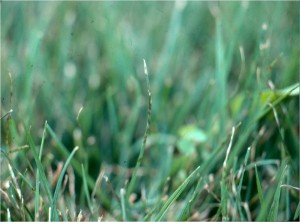
Purple and gray leaf spots on perennial ryegrass caused by Pyricularia oryzae. Photo: Richard Buckley, Rutgers PDL
Disease generally starts every year around the beginning of August. Anecdotally, we used to say that gray leaf spot appeared on the first “cold day of summer” (last night was 57ºF at my house). Small purple leaf spots with gray centers are the initial symptoms. These spots are distinct from those caused by other leaf diseases like brown patch or leaf spot and melting out. Unfortunately, most of us miss the leaf spot phase, because the spots quickly coalesce and consume entire leaves. Individual leaves twist into a classic “fish hook” symptom and infected turf often looks drought stressed.
If left unchecked, expect to see large areas of dead turf. Tall fescue and perennial ryegrass are susceptible cool season grasses grown in our area, but we almost exclusively see it in perennial ryegrass. Furthermore, perennial ryegrass cultivars exhibit a great deal of variability with regard to susceptibility to the disease. This is something we also see in the different cultivars of Hakone in nursery production settings and tall fescue in breeding plots.
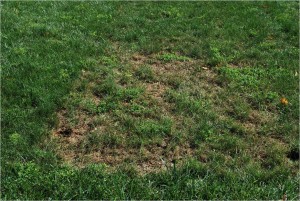
The perennial ryegrass in a low-maintenance seed mixture is selectively killed by gray leaf spot. Photo: Richard Buckley, Rutgers PDL
Seedlings, tall cut turf stands, soft and succulent grass, high nitrogen and irrigation inputs, and leaf wetness are all predisposing conditions for gray leaf spot. Proper management, of course, begins with mitigating as many of these conditions as possible. Unfortunately, this is a disease that often overcomes our best efforts.
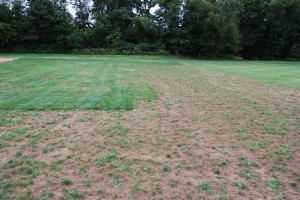
Gray leaf spot kills untreated border plots in fungicide trial on Rutgers research farm. Photo: Richard Buckley, Rutgers PDL
There is a silver lining to all the death and destruction. Our turfgrass breeders do a fine job improving perennial ryegrasses, so there are many resistant cultivars on the market. Resistance is the single cheapest and most effective disease control tactic we have, so I highly recommend that when seeding perennial ryegrass, use the new GLS resistant selections.
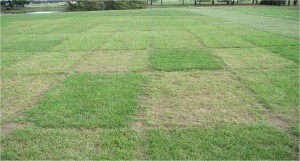
Resistance to gray leaf spots in perennial ryegrass plots. Photo: Dr. William Meyer, Rutgers University
First cold day of summer and Pyricularia is in town. Dr. Clarke just told us the disease showed up in his plots on the farm this morning – woohoo! Every silver lining has a Touch of Gray!
